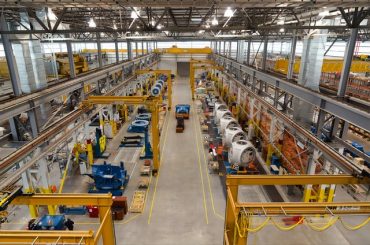
Equipment manufacturers and users want to leverage the insights derived by analyzing and modeling IoT and sensor data to transition from reactive to proactive operations.
The rapid adoption of IoT and embedded smart sensors by equipment manufacturers combined with new connectivity options are providing easy access to a wealth of rich operational data. Increasingly, equipment manufacturers and users want to leverage the insights derived by analyzing and modeling that data to transition from reactive to proactive operations. Recently, RTInsights sat down with Chris MacDonald, Head of AI and Analytics, Digital Transformation Solutions at PTC, to explore what’s driving interest in this area, the challenges companies face, and key technologies that contribute to success. Here is a summary of that conversation.
RTInsights: Why is there interest in moving to proactive operations, and why now?

MacDonald: Service and aftermarket are becoming important aspects of modern manufacturing businesses. Customers are demanding greater value, and manufacturers realize that long-term closer customer relationships are more profitable and sustainable. And if they are not, at the very least, they are a way of ensuring customers return to generate consistent revenue.
You have margins on the products that are continually squeezed. Companies and executives look towards service as a place to offset margin pressure by delivering greater value, forging closer customer relationships, offering opportunities to embed solutions deeper into those customer operations and provide additional products and services that are related to their core offerings.
The problem for many manufacturers is that much of the service and aftermarket business has been offloaded traditionally to third parties, who may not do things exactly the same way or follow guidelines to a tee. Going proactive is a way to regain control. It is actually regaining visibility at the very least, and then some level of control that allows you to standardize operations.
If you take service, which can have margins of 2.5x of new product sales, and you see many manufacturers generating 40 to 50% of their overall profit from the aftermarket, it’s easy to see why manufacturers start with proactive insights and proactive operations. That gives them the ability to listen to equipment and assets in the field and adapting operational motions to patterns they discover. Proactive operations also offer a way to protect the profitability of the service business. They can then offer more aggressive SLAs. If they do that, they’re much more likely to win profitable business and keep it over the longer term.
RTInsights: What are the benefits of using a proactive approach?
MacDonald: I’m going to use an analogy. Let’s take a step back and think about these physical assets or smart, connected products. You have telemetry data, and potentially other data about service from systems. That’s the equivalent of being able to hear. The question becomes, what do I listen to? There’s a lot of noise, so how do I pick out and listen to only what’s important?
Without even considering predictive and prescriptive analytics, think about features and statistical importance related to performance. It gives you the ability to hear clearly which notes are in or out of tune amidst the background noise.
Of course, you can always hear a scream. But usually, a scream comes from someone (or something) already in some sort of crisis, experiencing harm. So, you are dealing with problems reactively.
There’s a benefit of being able to truly listen to the right things. You can start to identify performance patterns and behaviors to diagnose what’s happening. Customers expect seamless operations. They tend to penalize the manufacturers who they believe, whether it’s right or wrong, caused them unplanned downtime. Hearing notes that are out of tune will allow you to address a problem before there’s a scream- from the equipment or from your customer.
Analytics deliver the diagnostic insights I was talking about. It can spot deviations from best practices or how equipment should be operated or used in an environment. Proactive operations based on those analytics spot problems before they arise.
With a connected product, you get a view into what is happening in the environment where the asset is operating. Analytics, especially advanced analytics, allows that data to be processed to identify statistically relevant anomalies, patterns, and events. That ultimately provides a more objective lens into what a problem really is.
Service efficiency can be improved with better planning and resource allocation. Predictive insights that help manufacturers transition from that break-fix or calendar-based service model can make service calls much more efficient, reducing things like overall truck rolls, callbacks, and more.
Without a connected product, we often send a technician out to do those diagnostics only to find out that they don’t have the right part on the truck, or the expertise needed to fix a problem. If a customer is experiencing operational downtime, this delays repair. Avoidance of failures is critical. But so too is the efficiency of the delivery of routine maintenance for operations or actions, rather than things like belt changes or lubrication. Many times, it’s more efficient to do the routine maintenance before it’s technically necessary. In that way, run-of-the-mill service calls can be transformed into higher-value touchpoints.
Also, a good technician with the right analytics knows what other problems to look for. They can run the right diagnostics to solve the problem quickly and gather additional data points to deliver better insights about the equipment in its environment.
The importance of such remote, self-service capabilities can’t be overstated, especially during a pandemic.
RTInsights: Do you see the use of prescriptive analytics and maintenance on a regular basis yet, or is it still too early?
MacDonald: Yes. There is use. But it tends to be more of a machine builder issue rather than having to do with manufacturing operations. One of our marquee analytics use cases is a tire manufacturer. The tire building machine has different set points. If it’s not done in a certain way, it either leads to rework or scrap, which ends up losing money and ultimately revenue loss.
The whole concept of prescriptive analytics took form because the data was available, and they knew their data. They could tie it to the operational outcomes from a predictive lens. They know what will happen before the step that leads to that outcome occurs. But they also had levers. In the machine builder context, the set points are actual levers or levers in the data. You could start to run optimizations and prescribe the different set points to prevent certain problems. That’s a use case equating to hundreds and hundreds of million dollars of ROI.
RTInsights: Are we speaking about ROI here?
MacDonald: It absolutely is, especially if you take it from an operational standpoint. Again think of me as the manufacturer of tire building machines or any other piece of equipment used in a manufacturing operation. My customer has to change the way they do things to get better use out of their equipment. Then I start to think to myself, wait a minute. Maybe my engineering specs are not developed based on long-term usage, or even simulate the right conditions. The set points are more dynamic than we expected.
That’s where you start to say: Maybe I need to start providing the analysis of these set points and provide an application to my end customer. Maybe if I have the insight into how my equipment is going to deliver value or challenges in operation, I can provide them with those insights, even as a service, to make sure those operational outcomes are met.
RTInsights: What underlying technologies are now needed for success?
MacDonald: The critical technology is, of course, the connectivity. It gives us the ability to contextualize where assets are and let us know the physical landscape in terms of data. With the right technology we can model the data in relation to its context.
But there are many other technologies that are important, as well. There’s system integration involved with edge connectivity to sensors. There are also other systems or service systems that may become a part of an overall proactive effort. The more you can provide capabilities and tools that simplify that system integration, the better.
Remote monitoring is the place where you start. As I said, you must be able to at least hear before you even start to listen.
I think augmented remote assistance, augmented 3D work instructions, and augmented expert capture, are critical. Things like service, parts management, and workflow management can derive insights from the analytics. Statistical calculations and machine learning make it easier.
Automated machine learning lets you create and more rapidly tune models to represent the data. This helps you get better predictions and results. And all of this must be improved with general analytics.
In addition, you need an application development platform. There’s a lot that goes into these proactive operations use cases. The most critical capabilities come down to the ability to connect, store and make sense of data, especially using advanced analytics techniques, like machine learning to build models to make predictions.
This must be done before you turn anything on. You must have real-time systems and applications to get data into those models. You must have systems and applications that can take the prediction and do something with it.
The upward spiral of insight and business value is tremendous. Without ubiquitous connectivity, it’s impossible to scale any proactive operations initiative beyond a pilot scale. Relying on manual, inconsistent methods to extract data just becomes less and less feasible.
Similarly, you need a variety of analytics techniques to be available at every step of the process to deliver that useful insight. A manufacturer may start with adding sensors to and remotely connecting to equipment in the field. They start setting thresholds that alert operators, remote technicians, service organizations to investigate that a piece of equipment may have a potential problem.
Those thresholds, with additional insight, can evolve into situations like rolling averages and benchmarks that take into account the understanding of normal usage and operating patterns. Investigations that are flagged can be fed into machine learning algorithms. They can uncover potentially causal patterns and produce rich automated diagnostics. They can then start making predictions and even prescriptions. It gives us the opportunity to rethink business and operational processes from the ground up. I think it’s a foundational way to transform service operations.
RTInsights: What are the challenges when using these technologies, and how does PTC help?
MacDonald: Fundamentally, that initial starting point, that connectivity, can be a challenge to enable proactive operations. It is necessary to connect to different devices and different versions of similar devices knowing those devices are likely operating under different conditions across one manufacturer and their entire customer base. The data measurements and the technical connectivity protocols are ultimately going to differ. PTC helps by offering capabilities that support hierarchies, federated from edge to cloud, that make it easier to define and iterate on those digital assets.
Manufacturers face a unique challenge in having limited data about the customer’s operating environment. So rarely do they have data outside of the connected equipment that they sell and service. That means they might not always have the labeled data. And they have to especially think about label outcome data because the outcome could be an operational piece.
They might have to use other techniques, such as anomaly detection and statistical monitoring. Those are good stepping-stones before predictive insights are possible. This is especially true in the cases where a circumstance or a failure mode is not clearly stored and persisted.
Lastly, proactive operations require integration into different systems for taking different action against predictive insights or any insights, whether that’s alerting visualization initiating a workflow and other systems. Having workflow tools and API integrations within a platform and software operating that you’re using is absolutely key and something to look for.
One key to all of this is to realize that, ultimately, digital transformation requires a committed effort. There needs to be collaboration and a willingness to learn and to iterate. You need this foundation to build on because it’s hard work implementing technology.
There’s no magic. The key to success is more than technology. Projects must be aligned to that overarching vision. There are a variety of stakeholders that must agree on common data definitions. There are engineers, architects, data scientists, and operators that must find a way to collaborate. They have traditionally existed in very separate universes. They must collaborate and iterate efforts to understand and derive insight. They must take better actions to understand how that data affects the real-world processes they wish to impact.
They all must be willing to make these data-driven decisions. And that requires executive leadership as a prerequisite for success. Leaders who toss an ill-defined project with unrealistic expectations are at a risk to fail. You must start with the business goals and work backward to a digital transformation vision. You must do this even before identifying the good projects to use as a building block for your strategy.
In short, modern leaders must have a vision that is both clear enough to organize around, and flexible enough to deal with inherent uncertainty in exactly how we iterate to get there. How to perfectly strike that balance is one of those things that tends to be clear in hindsight but can be quite difficult when looking forward.
RTInsights: Which industries and applications have the most to gain by moving to proactive operations?
MacDonald: Any manufacturer who provides equipment that is critical to customer operations can benefit. It is in situations where downtime is critical. Proactive operations also are broadly applicable to drive optimizations. But the business case is very strong, and the opportunity is immense for equipment or assets where downtime is critical, where service is costly, and especially where safety and regulatory compliance is a high priority.
A great example is Howden, which is a global leader in manufacturing air and gas handling solutions. Its equipment is used in sectors including infrastructure, power generation, oil and gas, wastewater, metals, mining, and transportation.
Their assets are critical to system health. They developed the Howden Uptime solution, initially for their high-end bespoke assets, which is a connected IoT solution. Their product displays insights, not just to their service organization, but also to their end customers.
Water concentration wasn’t part of that solution as it wasn’t monitored inline in the equipment or the asset. (Technicians were taking manual measurements routinely.) One of their oil and gas customers was having issues with this. The client’s natural instinct is to say, “Hey, the equipment’s not working. It’s causing downtime.” Howden wanted to understand the problem. It embedded a water prediction model into their application that allowed them to understand that it was something in the operation rather than the equipment. The model also provided insight about how to better use the equipment with the circumstances of the operation.
It was an opportunity based on one important client where they saw a tremendous opportunity to advance their overall IoT solution and find ways to continually deliver diagnostic and predictive insights. They could then use that solution with other clients.
And I think Howden would say, more than anything, the critical success factor is to understand the value created at the intersection of what they do. Data analytics and predictive modeling are foundational to accelerating the global move to servitization. And that said, a major part of the value of a proactive service project is building a blueprint that offers a strategic competitive differentiation in what is a very mature industrial market.






